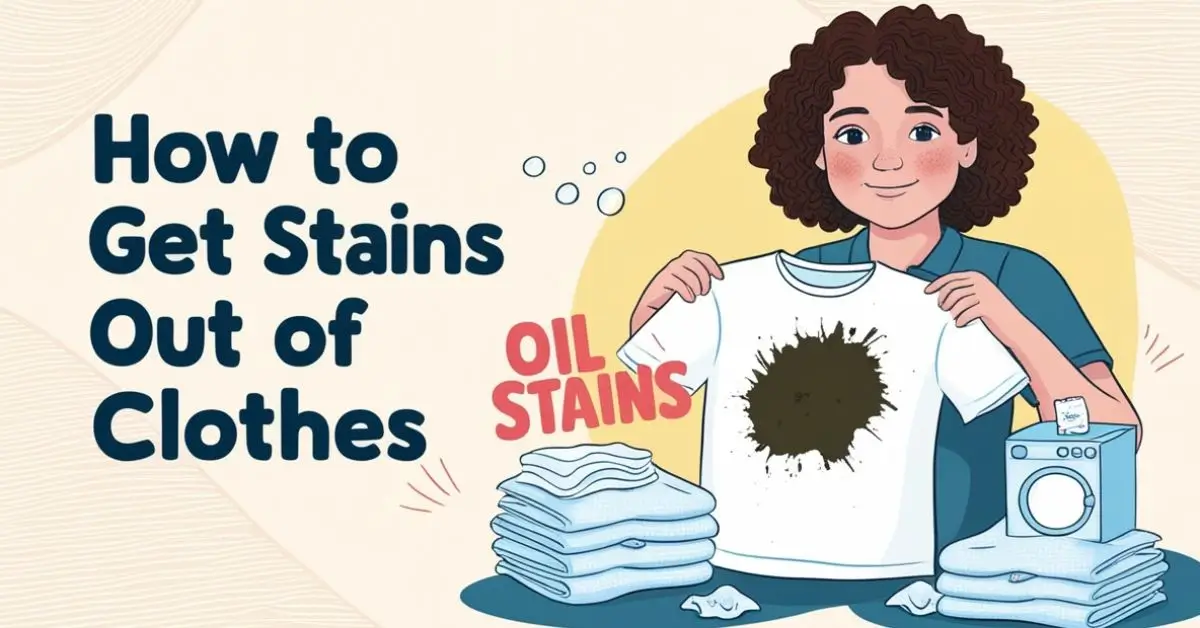Oil stains are one of the most stubborn types of stains that can mar clothing. Whether from a cooking mishap, a spill at dinner, or even oils from machinery, these stains are notoriously difficult to remove. What makes oil stains challenging is their ability to penetrate deep into fabric fibers, creating a bond that’s tough to break. This guide offers practical, effective methods for tackling oil stains, suitable for all types of fabrics. With the right tools, techniques, and a bit of patience, you’ll be able to restore your clothes to their former glory.
Understanding Oil Stains: What Makes Them So Stubborn?
Oil stains persist because of their unique chemical makeup. Oils are hydrophobic, meaning they repel water. When an oil stain occurs, the oil molecules bind with the fibers of your fabric instead of dissolving in water. Consequently, a regular wash cycle isn’t enough to remove these stains. Different oils create stains of varying intensities:
- Cooking Oils: These are often lighter in color but penetrate quickly due to their high lipid content.
- Motor Oils and Grease: Heavier and darker, these stains are prevalent on work clothing and require a bit more strength to eliminate.
- Body Oils: Natural oils from the skin can cause discoloration over time, especially on delicate fabrics like silk.
Knowing what type of oil you’re dealing with can help in choosing the best removal method.
Pre-Treatment: Preparing Your Clothes for Stain Removal
Before diving into any treatment, it’s essential to prepare the stain for removal. Acting quickly is crucial, as oil stains become more challenging to lift once they set.
- Blot, Don’t Rub: For fresh stains, use a clean cloth or paper towel to blot the excess oil gently. Rubbing can spread the stain, embedding it further into the fibers.
- Remove Excess Oil: Use the edge of a dull knife or a spoon to scrape off any residual oil. This is especially important for thicker oils like butter or motor grease.
- Prepare for Treatment: After removing as much excess oil as possible, you’re ready to apply one of the stain-removal methods listed below.
Effective Methods for Removing Oil Stains
Several household products can work wonders for lifting oil stains, especially when applied promptly.
1. Dish Soap
Dish soap is a classic solution because it’s designed to break down oils and grease on dishes, making it equally effective on clothing.
- Application Steps:
- Apply a small amount of dish soap directly to the stain.
- Use a soft brush (a toothbrush works well) to gently work the soap into the fabric.
- Let it sit for about 5-10 minutes, allowing the soap to penetrate the fibers and dissolve the oil.
- Rinse the area with warm water, then wash the garment as usual.
2. Baking Soda or Cornstarch
Baking soda and cornstarch are excellent absorbents and can lift oil from fabric without water, making them ideal for delicate or dry-clean-only garments.
- Application Steps:
- Cover the stain completely with baking soda or cornstarch.
- Let it sit for at least 15-20 minutes; for tough stains, leave it on longer, up to a few hours.
- Brush off the powder gently, then wash the garment if possible. Repeat if the stain persists.
3. Using Vinegar and Baking Soda
The combination of vinegar and baking soda creates a chemical reaction that can help lift oil from fabrics.
- Application Steps:
- Dab a small amount of white vinegar onto the stained area.
- Sprinkle baking soda over the vinegar to create a mild fizzing reaction.
- Use a toothbrush to gently scrub the stain.
- Let it sit for 10-15 minutes before rinsing with warm water and laundering as usual.
4. Rubbing Alcohol
Rubbing alcohol is effective for removing grease stains because it evaporates quickly and lifts oil particles with it.
- Application Steps:
- Apply rubbing alcohol to the stain with a cotton ball or cloth, blotting instead of rubbing.
- After a few minutes, check to see if the stain lightens. If it does, rinse the area with water.
- Launder the item, and avoid heat drying until the stain is gone.
5. Shampoo for Body Oils
If body oils or oily hair products are the culprits, shampoo can effectively break down the stain.
- Application Steps:
- Apply a small amount of shampoo to the stained area.
- Rub the fabric gently to work the shampoo into the fibers.
- Let it sit for 5-10 minutes, then rinse and launder as usual.
Using Commercial Stain Removers
Commercial stain removers, such as those specifically for oil or grease, can provide effective results.
- Choosing the Right Product: Look for products labeled as “grease remover” or “oil stain remover,” as these are formulated to target oil.
- Application Guidelines: Always follow the manufacturer’s instructions, and test the product on an inconspicuous area first to ensure it doesn’t damage the fabric.
Specialty Techniques for Specific Fabrics
Different fabrics require unique care when treating oil stains to avoid damaging the material.
1. Removing Oil from Delicate Fabrics (Silk, Wool)
For delicate fabrics, avoid harsh chemicals or scrubbing. Instead, try a gentler approach:
- Apply cornstarch or talcum powder to absorb the oil without needing water.
- Let it sit overnight if possible, then brush it off.
- If a stain persists, use a mild detergent and cold water to treat the area carefully.
2. Heavy-Duty Oil Stains on Denim and Workwear
Denim and other heavy fabrics can endure stronger treatments:
- Apply a heavy-duty degreaser or dish soap directly to the stain.
- Let the soap sit for 10-15 minutes, then scrub with a brush.
- Launder in the hottest water safe for the fabric.
Tips for Washing and Drying Stained Clothes
- Avoid Heat Until the Stain is Gone: Heat can set oil stains permanently, so avoid using a dryer until you’re sure the stain is removed.
- Check Before Drying: After washing, inspect the garment to see if the stain remains. If it’s still visible, repeat the treatment steps before drying.
- Use Warm Water for Washing: Warm water helps to lift oil from fabrics, but be mindful of the care label to avoid shrinking or damaging the material.
Preventing Oil Stains in the Future
- Protective Measures: When working with oils, consider wearing an apron, especially if you’re in the kitchen or garage.
- Choosing Oil-Resistant Fabrics: Some fabrics are naturally more resistant to oil, such as polyester or treated cotton. If you work frequently with oils, consider clothes made of these materials.
Conclusion
Removing oil stains can be a daunting task, but with prompt action and the right methods, it’s entirely possible to tackle even the toughest stains. From simple dish soap to baking soda, rubbing alcohol, and commercial stain removers, there’s a solution for every type of oil stain. Remember to handle delicate fabrics with care and avoid heat until the stain is completely gone. By following these guidelines, you’ll keep your clothes in top condition, free of unsightly stains.
With these tips in hand, you’re equipped to handle any oil stain that comes your way, ensuring your wardrobe remains pristine and stain-free.











